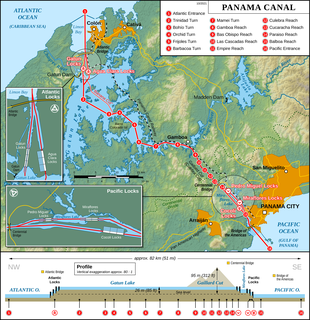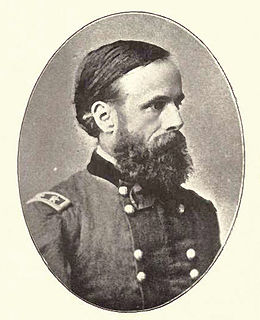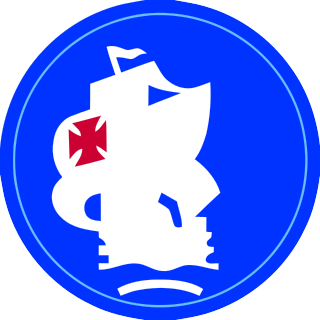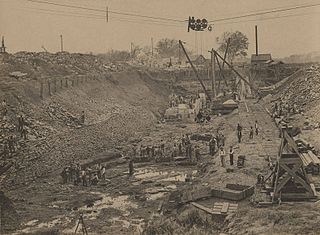
The Panama Canal is an artificial 82 km (51 mi) waterway in Panama that connects the Atlantic Ocean with the Pacific Ocean. The canal cuts across the Isthmus of Panama and is a conduit for maritime trade. One of the largest and most difficult engineering projects ever undertaken, the Panama Canal shortcut greatly reduces the time for ships to travel between the Atlantic and Pacific oceans, enabling them to avoid the lengthy, hazardous Cape Horn route around the southernmost tip of South America via the Drake Passage or Strait of Magellan and the even less popular route through the Arctic Archipelago and the Bering Strait.

George Washington Goethals was a United States Army General and civil engineer, best known for his administration and supervision of the construction and the opening of the Panama Canal. He was the State Engineer of New Jersey and the Acting Quartermaster General of the United States Army.

The Goethals Bridge is the name of a pair of cable-stayed bridge spans connecting Elizabeth, New Jersey, to Staten Island, New York, in the United States. The spans cross a strait known as Arthur Kill, and replace a cantilever bridge span built in 1928. The bridge is operated by the Port Authority of New York and New Jersey.

The Panama Canal Zone was a 553-square-mile (1,430 km2) territory inside of Panama, consisting of the Panama Canal and an area generally extending 5 miles (8.0 km) on each side of the centerline, but excluding Panama City and Colón, which would have otherwise fallen in part within the limits of the Canal Zone. Its border spanned two of Panama's provinces and was created on November 18, 1903, with the signing of the Hay–Bunau-Varilla Treaty. When artificial lakes were created to assure a steady supply of water for the locks, those lakes were included within the zone.

Balboa is a district of Panama City, located at the Pacific entrance to the Panama Canal.

The United States Southern Command (USSOUTHCOM), located in Doral, Florida in Greater Miami, is one of the eleven unified combatant commands in the United States Department of Defense. It is responsible for providing contingency planning, operations, and security cooperation for Central and South America, the Caribbean, their territorial waters, and for the force protection of U.S. military resources at these locations. USSOUTHCOM is also responsible for ensuring the defense of the Panama Canal and the canal area.

William Crawford Gorgas KCMG was a United States Army physician and 22nd Surgeon General of the U.S. Army (1914–1918). He is best known for his work in Florida, Havana and at the Panama Canal in abating the transmission of yellow fever and malaria by controlling the mosquitoes that carry these diseases. At the time, his strategy was greeted with considerable skepticism and opposition to such hygiene measures. However, the measures he put into practice as the head of the Panama Canal Zone Sanitation Commission saved thousands of lives and contributed to the success of the Canal's construction.

The Culebra Cut, formerly called Gaillard Cut, is an artificial valley that cuts through the Continental Divide in Panama. The cut forms part of the Panama Canal, linking Gatun Lake, and thereby the Atlantic Ocean, to the Gulf of Panama and hence the Pacific Ocean. It is 7.8 miles (12.6 km) from the Pedro Miguel lock on the Pacific side to the Chagres River arm of Lake Gatun, with a water level 85 feet (26 m) above sea level.

Edgar Jadwin, C.E. was a U.S. Army officer who fought in the Spanish–American War and World War I, before serving as Chief of Engineers from 1926 to 1929.

The idea of the Panama canal dates back to 1513, when Vasco Núñez de Balboa first crossed the isthmus. The narrow land bridge between North and South America houses the Panama Canal, a water passage between the Atlantic and Pacific Oceans. The earliest European colonists recognized this potential, and several proposals for a canal were made.

Chester Harding was Governor of the Panama Canal Zone from 1917 to 1921.

Joseph Cowles Mehaffey was a major general in the United States Army. As a member of the Army Corps of Engineers, he was the consulting engineer on the Arlington Memorial Bridge in Washington, D.C.; helped renovate the White House; and served as a supervising engineer for the Works Progress Administration during the Great Depression. He was assigned in 1941 as an engineer on the Panama Canal, and was Governor of the Panama Canal Zone from 1944 to 1948.

Henry Larcom Abbot was a military engineer and career officer in the United States Army. He served in the Union Army during the American Civil War and was appointed brevet brigadier general of volunteers for his contributions in engineering and artillery. In 1866 he received additional brevet appointments as major general of volunteers and brigadier general in the Regular Army. He conducted several scientific studies of the Mississippi River with captain, later Major General Andrew A. Humphreys. After his retirement, Abbot served as a consultant for the locks on the Panama Canal. He was elected a Fellow of the American Academy of Arts and Sciences in 1863.

The Goethals Medal is a national award given annually by the Society of American Military Engineers (SAME) to a registered engineer who is also a member of SAME prior to nomination. The nominated engineer must have made eminent and notable contributions in engineering, design, or construction in the past five years.

United States Army South is an Army service component command of United States Southern Command whose area of responsibility includes 31 countries and 15 areas of special sovereignty in Central and South America and the Caribbean. It is headquartered at Fort Sam Houston, Texas.
The Isthmian Canal Commission was an American administration commission set up to oversee the construction of the Panama Canal in the early years of American involvement. Established the February 26, 1904, it was given control of the Panama Canal Zone over which the United States exercised sovereignty. The commission reported directly to Secretary of War William Taft.

Plaquemine Lock State Historic Site, located in Plaquemine, Louisiana, commemorates an early example of hydraulic engineering design and the historic significance of Bayou Plaquemine, an important navigable waterway that was once a distributary of the Mississippi River. Bayou Plaquemine promoted settlement beginning in the 18th century and helped the area economically by providing an access route between southwestern Louisiana and the Mississippi via the Atchafalaya Basin.

Riverton Lock, also known as the Colbert Shoals Lock, was the entrance to Colbert Shoals Canal, a low water alternative route around Colbert and Bee Tree Shoals on the Tennessee River.

The Panama Canal Department was a department of the United States Army, responsible for the defense of the Panama Canal Zone between 1917 and 1947.


















